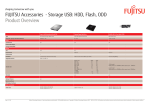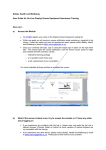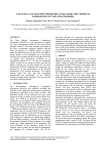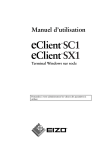Transcript
RADIATION FROM HYDROGEN ATOMS RELATED TO THE MODELLING OF THE EXTRAP T2R PLASMA Viorica Stancalie1 and Elisabeth Rachlew2 1) National Institute for Laser, Plasma and Radiation Physics, Bucharest, Romania 2) Atomic and Molecular Physics, The Royal Institute of Technology (KTH), Stockholm, Sweden The goal of this work is to create a computationally ‘light’ spectrally resolved computer model, which would fit reasonably well to the experimentally measured spectrum of the Balmer series limits. The reason for choosing these spectra is because this allows us to observe the line radiation from the neutral atoms. The completion of this model will be an integration of the line of sight intensities, such that the theoretical spectrum would fit the experimental within a factor of order unity. The organization of this paper is as follows. Starting from an overview of the different physical properties of the EXTRAP T2R plasma, which is basically hydrogen (deuterium), with all its non –negligible contributors [1] we give the contributions to the spectrum from the statistical plasma microfields, the line radiation, the photo recombination and bremsstrahlung. In atomic hydrogen the Balmer series lies in the visible spectrum, between 6563 Å and 3646 Å at the series limit. The spectrum around the series limit is of special interest. The series limit is located at the wavelength an emitted photon would have if a free ‘zero kinetic energy’ electron recombined with an ion. Under the given plasma parameters of low temperatures (~1eV) and high densities (≥ 1012 cm-3) there is a market rise in photo recombination. The spectrally resolved intensity I(λ) of the photo recombination radiation includes the wavelength dependences via the energy of the emitted photon: I nη I phr (n,η , E ph )dE ph = ne ni D kT g ( E ph / I nη , n)dE ph 3/ 2 I nη exp kT x (1) where η and n are are quantum states (η→n), Inη is the energy difference between states η and n and Eph= ħω is the photon energy. Equation (1) can then be integrated over all free states η, to give the photo-recombination to state n at a given wavelength. Here, D=(64√π/3√3)α4a02c (m3s-1) is a constant and g(n,x), the free-bound Gaunt factor, which is the quantum mechanical correction. The bremsstrahlung contribution from the core is in the low wavelength regime (X-ray to UV). When bremsstrahlung is treated quantum mechanically, the only thing that changes is the Gaunt factor. Given a photon wavelength, electron temperature and target ion charge, we have calculated the value of the Maxwellaveraged free-free Gaunt factor, g (λ, Te, Z) using the method of Burgess [3]. The atomic spectra, transition probabilities, population densities, line radiation and photorecombination were analysed on the basis of atomic data and program package ADAS [4] . The main routine calculates the emission spectrum in a wavelength, electron density and temperature range. This routine calculates the continuum emission (free-free and free bound) as a function of wavelength. The Fortran version of the code generates the total emission for hydrogen plus single impurity plasma, which in our case is oxygen. No ionization balance is assumed but the code requires all ion stages so a coronal balance is used. The rate coefficients for ionization and recombination are imported from ADAS. REFERENCES [1] J. Sallander, A. Hedqvist, E. Rachlew, J. Phys. B:At. Mol. Opt. Phys. 31 (1998) 3905 [2] L.C.Johnson, Astrophysical Journal 174 (1972)227-236; [3] A. Burgess, J. Phys. B.:At. Mol.Phys. 7(1974)L364-L367 [4] H.P.Summers, ADAS User manual Version2.1,http://patiala.phys.strath.ac.uk/ad as





